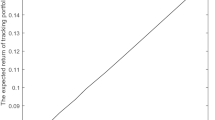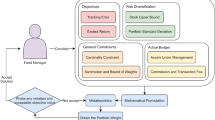Abstract
We consider a robust optimization approach for the problem of tracking a benchmark portfolio. A strict subset of assets are selected from the benchmark such that the expected return is maximized subject to both risk and tracking error limits. A robust version of the Fama-French 3 factor model is developed whereby uncertatiny sets for the expected return and factor loading matrix are generated. The resulting model is a mixed integer second-order conic problem. Computational results in tracking the S&P 100 out of sample show that the robust model can generate tracking portfolios that have better tracking error and Sharpe ratio than those generated by the nominal model.










Similar content being viewed by others
References
Ben-Tal A, Nemirovski A (1998) Robust convex optimization. Math Op Res 23(4):769–805
Ben-Tal A, Nemirovski A (2000) Robust solutions of linear programming problems contaminated with uncertain data. Math Program 88(3):411–424
Ben-Tal A, Margalit T, Nemirovski A (2000) Robust modeling of multi-stage portfolio problems. In: Frenk H, Roos K, Terlaky T, Zhang S (eds) High performance optimization, applied optimization, vol 33. Springer, US, pp 303–328
Bertsimas D, Pachamanova D (2008) Robust multiperiod portfolio management in the presence of transaction costs. Comput Oper Res 35(1):3–17
Bertsimas D, Brown DB, Caramanis C (2011) Theory and applications of robust optimization. SIAM Rev 53(3):464–501. doi:10.1137/080734510
Birge JR, Louveaux F (2011) Introduction to stochastic programming. Springer
Boyd S, Vandenberghe L (2004) Convex optimization. Cambridge University Press, New York
Burmeister E, Roll R, Ross SA (2003) Using macroeconomic factors to control portfolio risk. Tech Rep
Canakgoz N, Beasley J (2009) Mixed-integer programming approaches for index tracking and enhanced indexation. Eur J Op Res 196(1):384–399
Chang T, Meade N, Beasley J, Sharaiha Y (2000) Heuristics for cardinality constrained portfolio optimisation. Comput Op Res 27:1271–1302
Chen C, Kwon RH (2012) Robust portfolio selection for index tracking. Comput Op Res 39(4):829–837
Chen C, Li X, Tolman C, Wang S, Ye Y (2013) Sparse portfolio selection via quasi-norm regularization, working paper
Chopra VK, Ziemba WT (1993) The effect of errors in means, variances, and covariances on optimal portfolio choice. J Portf Manag 19(2):6–11
Corielli F, Marcellino M (2006) Factor based index tracking. J Bank Financ 30(8):2215–2233
Cornuejols G, Tutuncu R (2006) Optimization methods in finance. Finance and risk, Cambridge University Press, Mathematics
D’ecclesia RL, Zenios SA (1994) Risk factor analysis and portfolio immunization in the italian bond market. J Fixed Income 4(2):51–58
Erdogan E, Goldfarb D, Iyengar G (2004) Robust portfolio management. Tech Report CORC TR-2004-11, IEOR, Columbia University, New York
Fama E, French K (1993) Common risk factors in the returns on stocks and bonds. J Financ Econ 33(1):3–56
Gulpinar N, Katata K, Pachamanova DA (2011) Robust portfolio allocation under discrete choice constraints. J Asset Manag 12:67–83
Goldfarb D, Iyengar G (2003) Robust portfolio selection problems. Math Op Res 28(1):1–38. doi:10.1287/moor.28.1.1.14260
Gurobi Optimization I (2015) Gurobi optimizer reference manual
Jorion P (2003) Portfolio optimization with tracking error constraints. Financ Anal J 59(5):70–82
Karlow D, Rossbach P (2011) A method for robust index tracking. In: Hu B, Morasch K, Pickl S, Siegle M (eds) Operations research proceedings 2010. Operations research proceedings. Springer, Berlin Heidelberg, pp 9–14
Kolbert F, Wormald L (2010) Robust portfolio optimization using second-order cone programming
Lejeune MA, Samatlı-Paç G (2013) Construction of risk-averse enhanced index funds. INFORMS J Comput 25(4):701–719
Mulvey JM, Vanderbei RJ, Zenios SA (1995) Robust optimization of large-scale systems. Op Res 43(2):264–281. doi:10.1287/opre.43.2.264
Sadjadi SJ, Gharakhani M, Safari E (2012) Robust optimization framework for cardinality constrained portfolio problem. Appl Soft Comput 12(1):91–99
SPs (2015) http://www.us.spindices.com
Tutuncu R, Koenig M (2004) Robust asset allocation. Annals Op Res 132(1–4):157–187
Zenios SA (2006) Practical financial optimization: decision making for financial engineers. Blackwell, Incorporated
Author information
Authors and Affiliations
Corresponding author
Appendix 1: Parameter generation for the robust tracking model
Appendix 1: Parameter generation for the robust tracking model
We applied the same procedure described in Goldfarb and Iyengar (2003) to three-factor model for constructing factor-based robust index tracking models. We follow Goldfarb and Iyengar (2003) closely. Suppose the return vector r is given by the linear regression model:
where \(\mu \in R^{n}\) is the vector of mean returns, f \(\sim N\left( 0,F\right) \in R^{m}\) is the vector of returns of the factors that drive the market, \(V\in R^{m\times n}\) is the matrix of factor loadings of the n assets, and \(\epsilon \sim N\left( 0,D\right) \) is the vector of residual returns.
Let \(S=\left[ r^{1},r^{2},\ldots ,r^{p}\right] \in R^{n\times p}\) be the matrix of asset returns and \(B=\left[ f^{1},f^{2},\ldots ,f^{p}\right] \in R^{m\times p}\) be the matrix of factor returns, then (39) which can be represented by the following linear model:
where \(y_{i}=\left[ r_{i}^{1},r_{i}^{2},\ldots ,r_{i}^{p}\right] ^{T},A= \left[ 1,B^{T}\right] ,x_{i}=\left[ \mu _{i},V_{1i},V_{2i},\ldots ,V_{mi} \right] ^{T}\) and \(\epsilon _{i}=\left[ e_{i}^{1},e_{i}^{2},\ldots ,e_{i}^{p} \right] ^{T}\).
As we shown in Sect. 4.1, for single factor model, we set \(B= \left[ f^{1},\,f^{2}\right] =\left[ r_{M},r_{f}\right] ^{T}\); for three factor model, \(B=\left[ f^{1},\,f^{2},\,f^{3},\,f^{4}\right] =\left[ r_{M},r_{f},SMB,HML \right] ^{T}\). The least-squares estimate \(\overline{x}_{i}\) of the true parameter \(x_{i}\) is given by
Substituting \(y_{i}=Ax_{i}+\epsilon _{i}\) into (40), we get \(\overline{ x}_{i}-x_{i}=\left( A^{T}A\right) ^{-1}A^{T}\epsilon _{i}\sim N\left( 0,\Sigma \right) \) where \(\Sigma =\sigma _{i}^{2}\left( A^{T}A\right) ^{-1}\) . \(\sigma _{i}^{2}\) is unknown in practice, so we replace \(\sigma _{i}^{2}\) by \(\left( m+1\right) s_{i}^{2}\) where \(s_{i}^{2}\) is the unbiased estimate of \(\sigma _{i}^{2}\). \(\sigma _{i}^{2}\) is given by
and the resulting variable
is a F-distribution with \((m+1)\) degrees of freedom in the numerator and \( (p-m-1)\) degrees of freedom in the denominator Goldfarb and Iyengar (2003).
By setting the joint confidence region \(\omega \) for set \(\left( \mu ,V\right) \), Goldfarb and Iyengar (2003) derive the following result for the parameters that can be used in our robust model:
where \(c_{J}\left( \omega \right) \) be the \(\omega \)-critical value. More prove details read in Goldfarb and Iyengar (2003). Then a worst case bound for the covariance matrix is achieved by 3 factor model, i.e. \( cov=V_{0}^{T}FV_{0}+\overline{D}\), where \(\overline{D}=diag\left( s_{i}^{2}\right) \). The uncertainty set for \(\mu \) in (43) will be used in for robust portfolio returns and \(V_{0}\) in (44) will be used to relative robust covariance.
Rights and permissions
About this article
Cite this article
Kwon, R.H., Wu, D. Factor-based robust index tracking. Optim Eng 18, 443–466 (2017). https://doi.org/10.1007/s11081-016-9314-5
Received:
Revised:
Accepted:
Published:
Issue Date:
DOI: https://doi.org/10.1007/s11081-016-9314-5




